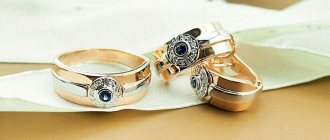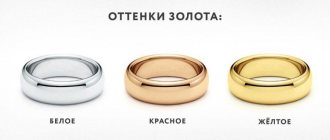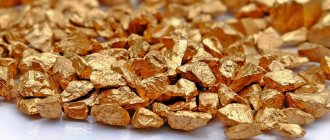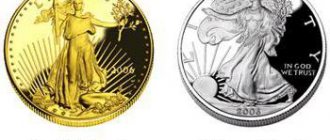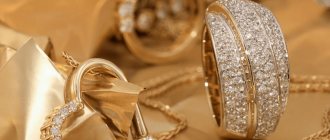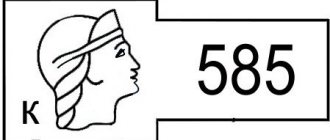375th
Three hundred and seventy-five is a low-grade alloy, unpopular with jewelers. It is 9 carats. Contains 37.5% precious metal. Depending on the alloy, it has different shades: the more copper, the more orange the alloy turns out. A large percentage of silver gives a white tint.
Used for accessories, wristwatches, cup holders, forks, spoons, glasses, shot glasses, vases.
Advantages: strength and wear resistance due to low gold content. Disadvantages - price per gram (about 1300 rubles). The price may increase due to semi-precious stones and a high percentage of palladium in the alloy. Designer jewelry with a complex design is valued higher.
The surface quickly loses its presentation - it becomes dull and becomes stained. Needs regular cleaning. The alloy causes allergies, leaves stains and black stripes on the skin.
500th
500 standard is better than 375 due to the high content of precious metal in the alloy - 50%. The ligature consists of silver and copper. It is 12 carats.
It has a hue from bright yellow to deep orange depending on the percentage of copper and silver. Russian jewelers do not work with the sample due to the low gold content. Orders are carried out privately; jewelery of the 500th standard is not sold in jewelry stores.
It is used for accessories, gold plating for silver jewelry, and for medical purposes - for teeth and crowns.
When selling, the 500th hallmark of gold is not the most expensive. They give no more than 2,500 rubles per gram, and in pawn shops and resellers the price will be even lower.
Pros - wear resistance and low price, disadvantages - low-quality ligature that causes allergic reactions, spots and black stripes on the skin. Rings and earrings from the 500th are worn every day, but they quickly lose their presentation. Clean the surface regularly. Under the guise of an expensive sample, in Egypt and Turkey they sell the 500th sample, which after a month loses its marketable appearance.
Yellow, red or white gold: which is better and what are the differences?
Gold is the luxury and elegance of a noble “sunny” metal, often combined with semi-precious and precious stones. They never go out of fashion and are valued much higher than silver jewelry. Jewelry craftsmen give the precious metal a variety of shapes, which can be classic or in line with the prevailing trend.
The difference between jewelry is not only in design. Yellow, red or white gold can be used to create jewelry, each of which looks beautiful in its own way, but invariably raises the question as to which one is better and what the differences between them are.
Content:
- Three colors of gold;
- Why are jewelry made from gold alloys?
- Red gold;
- Yellow gold;
- White gold;
- Which gold is better?
- Summarizing.
Three colors of gold
The term “gold” when applied to jewelry is relative. In jewelry, alloys are used when precious metal is mixed with other chemical elements to produce yellow, red or white gold, as well as some other shades.
Ligature - the ratio of impurities and the main element in the alloy is reflected in the sample. The conditional “reference” value is “24 carats” or “1000”. And if the standard of the product is 585, then it is made of an alloy that contains 585 units of gold (pure) and 415 parts - alloying elements.
The introduction of a certain amount of copper, silver, palladium, zinc, nickel determines the color of gold:
- Yellow. It is a ligature made of gold, silver, copper. Since ancient times, it has symbolized wealth and power, a noble position in society, and has not lost its relevance today. It can have different shades from light to dark. It all depends on the amount of silver.
- Red. Its composition differs little from yellow, but the amount of copper taken is many times greater. The latter is the “secret” of the characteristic color. It was practically the only alloy common in the USSR. These times were different in that there was no question before a person as to what kind of yellow, red or white gold to buy.
- White. It looks similar to platinum, but is much cheaper. This has become the reason for the increased demand for jewelry made from it in recent years. It gets its hue thanks to nickel, palladium, and platinum. The first one is the cheapest and is prohibited in many countries due to the possible manifestation of an allergy to the alloy, which can also quickly darken. Ligature with platinum is considered noble, which is reflected in the cost.
Entry How to wear silver: rules for a stylish combination
It is necessary to understand that yellow, red or white gold can have a similar sample, that is, the same amount of precious metal in the composition. The acquired shade is determined by the ratio of alloying elements. In relation to a white alloy, it also matters whether palladium, platinum or nickel is included in the composition. This affects both cost and quality.
Why are jewelry made from alloys and not pure gold?
The purest alloy of precious metal is red. Secondary impurities in its composition cannot exceed ten percent, and the fineness cannot be lower than 916. This material has a high cost and consists almost entirely of gold, but its inherent softness and fragility did not contribute to the spread of jewelry, such as earrings, made of red alloy.
The only way to compensate for the deficiency is to increase the mass, and, accordingly, the weight of the jewelry. A small ring or earrings made of .999 gold will deform slightly or severely over time.
In order for a simple and uncomplicated wedding ring to last a long time, its weight should start from 8 grams or more.
The high cost and limited design led to the need to introduce secondary metals. And if relatively recently it was possible to purchase only yellow, red or white gold, in recent years, depending on the composition of the alloy, the following shades have appeared:
- blue;
- blue;
- violet;
- green;
- black;
- grey;
- brown.
Unusual green, blue, violet, light blue alloys are quite vulnerable and are most often used as inserts to replace precious stones. There are not very many fans of such “exotic” products, and the production of products is limited. Yellow, red or white gold is in much greater demand, which is often used by both private small workshops and world-famous jewelry houses.
There is one thing to consider about the color of gold. The hue is not always the result of ligature, that is, the introduction of various secondary metals. There are laser processing techniques and chemical reactions to achieve the desired color. Jewelry made from precious metal obtained in this way is valued much lower than from alloys, which should definitely be taken into account before purchasing.
Post Women's watches: rules for choosing watches
Red gold
Well known to the older generation, it has several different shades. On sale you can find pale, dark, bright and other shades of red gold. Most residents of the post-Soviet space associate products made from it with something outdated.
Many buyers, when considering yellow, red or white gold, prefer the first and last alloy. The red-colored precious metal is inferior in terms of nobility to its competitors, but remains relevant. It is often used as an additional element of complex products.
Rings, rings, watches, and bracelets made of red gold look most advantageous. Experiments with the percentage of additives made it possible to obtain a pink-colored precious metal. It is quite popular, and jewelry made from it is mostly more affordable.
Yellow gold
It personifies the nobility of the precious metal and is associated specifically with gold. It comes in light “lemon” and darker shades. Unlike red, it is more versatile and goes well with various precious and semi-precious stones, such as pearls, and looks good with European and Oriental clothing.
Among the advantages of the “solar” alloy are the following:
- Color . A ligature that produces a yellow tint represents exclusively gold.
- Versatility. Looks great on its own and suits those with both dark and light skin.
- Variety . Yellow gold jewelry can be simple or intricate, with precious and semi-precious stones.
- Availability. Due to the absence of expensive secondary metals, unlike white, which requires palladium or platinum, it has a lower cost.
It should be remembered that yellow, red or white gold is graded according to its purity, so the price may vary for similar products, either down or up. The more precious metal in the “sunny” shade of the alloy, the higher the price.
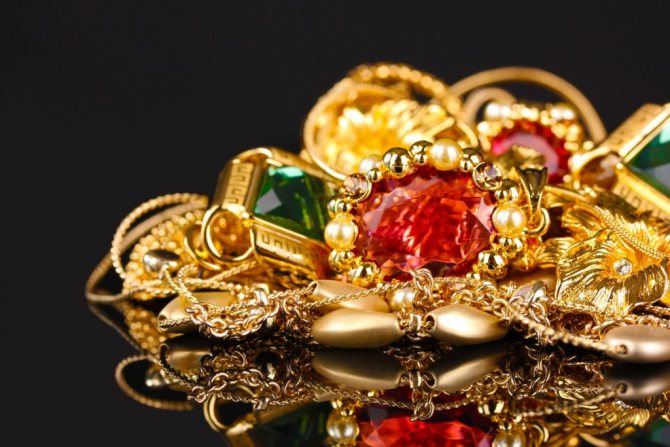
White gold
An increasingly popular precious metal alloy today, it has become a more affordable alternative to platinum. It is combined with diamonds and natural black pearls. It invariably attracts attention and testifies to the impeccable taste of its owner.
The main advantages of white gold include:
- Prestige. Jewelry similar to platinum evokes admiration and increases the status of its owner in the eyes of others.
- Originality. Jewelry made from this alloy is distinguished by intricate shapes and highly complex designs.
- Trend. White gold is at the peak of its popularity, which means that the owner of such jewelry is a person who follows fashion trends.
Post Pearl jewelry: how to choose and what to wear with it?
The most accessible alloy is considered to be nickel, but it is prohibited as an allergen in a number of countries. Galvanization can eliminate the disadvantage. And if, when choosing yellow, red or white gold, preference is given to the latter, and it contains nickel, you need to clarify this point with the seller. Otherwise, there is a possibility of rashes and irritation on the skin.
Palladium is safe, but less hard and less polishable. Platinum gives the alloy a noble shine and strength and does not cause allergic reactions. This white gold ligature has no complaints. The only downside is the high cost, which is fully justified by the luxurious appearance of the jewelry.
Which gold is better?
There is no clear answer to this question. It is important to understand that yellow, red or white gold is made by adding varying percentages of secondary metals to enhance the quality of the final jewelry piece. The shade has nothing to do with the sample. It only demonstrates the amount of gold in the alloy.
The main criteria that you should focus on are your own preferences, the outfit for which you are purchasing the jewelry or set, and the standard of the precious metal. The most common is 585. Jewelry of 750 is less common. They are more expensive and are most often intended not for everyday wear, but for going out.
The most fashionable and expensive is white, and the most common and affordable is yellow. Products made of red gold have their fans, but more preference is given to rings made of this metal in a lighter color, that is, close to a pink palette.
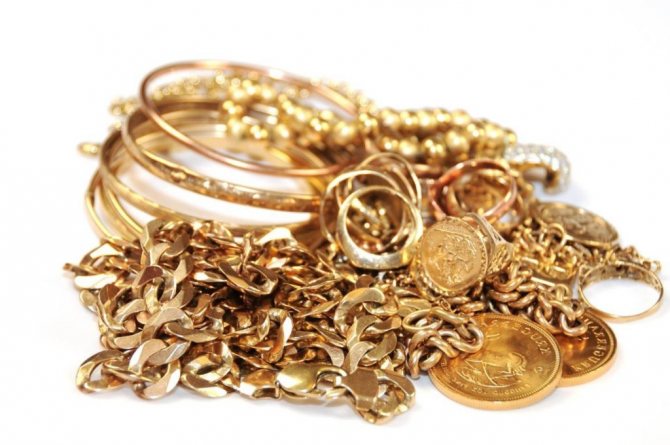
Summarizing
It must be remembered that yellow, red or white gold can have different compositions. It depends on the country of manufacture and jewelry house. Some save money and introduce cheap impurities into the remaining 415 (585 standard) or 250 (750 standard) parts, and sell them as expensive jewelry. The color of gold is a matter of taste, but you should pay close attention to the quality of the alloy and purchase jewelry from trusted brands.
585th
Jewelers talk about five hundred and eighty-fifth when answering the question which standard of gold is the best. 585 is suitable for daily wear. The alloy contains 58.5% gold and silver, nickel, copper. The color varies from white to red depending on the percentage of metals in the alloy. Silver and platinum give a white tint, copper - red.
Gold red shade is popular in China, Turkey, and India.
The advantage is the price/quality ratio. Bracelets, chains, and rings are durable, do not lose their appearance, and do not require regular cleaning or special storage conditions.
Does not cause allergies, skin redness, itching, does not leave spots or streaks. The surface does not darken or lose its shine.
585 is cheaper than other samples and is sold in jewelry stores, pawn shops, and online auctions. Suitable for thin elements. The content of the ligature allows you to achieve incredible shades.
Which gold is more expensive?
Jewelry store workers hear this question. Qualified sales consultants must know the difference between types of gold and minor components.
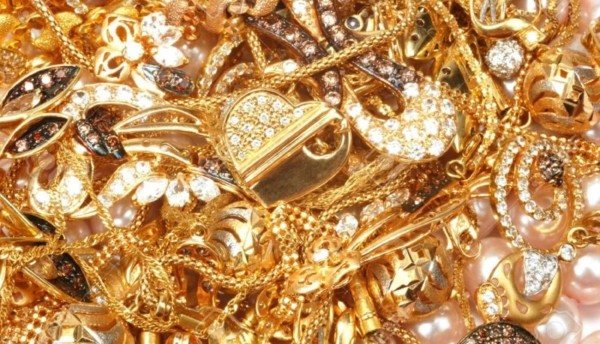
The price depends on the product sample. The higher the standard, the more expensive the jewelry. The product has a certain ratio of all components, which affects the sample.
You may be interested in: Why do you dream about an engagement ring? Interpretation of sleep
Pure gold is never used for jewelry trinkets; it is soft and impractical, so various precious metals are added to it to obtain a high-quality finished product.
The value of jewelry is influenced by the amount of additives in pure gold: copper, silver, nickel, platinum or palladium. All gold and silver samples are controlled within the framework of the law.
750th
Seven hundred and fiftieth is a pure sample with a precious metal content of 75%. Used for “going out” jewelry from premium brands. Not used as a base metal due to its fragility. Massive thick rings and bracelets are made from 750 gold. Prestigious Italian brands use it as a base for enamel.
The 750 is used to make small parts, fasteners, and thin elements.
Depending on the content of the alloy (silver, copper, palladium, platinum, nickel) it changes color from bright yellow to black. It is 18 carats.
Used in medicine, automotive and industry, it has the status of “gold standard”.
Suitable for processing and polishing. Various shades are possible. Does not cause allergies, spots, redness, or itching on the skin. Does not leave streaks. The disadvantage is the low percentage of wear resistance. With daily wear, it quickly loses its presentation: it wrinkles and becomes covered with scratches. Cost gives products status.
958th
Nine hundred fifty-eighth consists of 95.8% base metal and the remaining percentage alloy. Depending on the alloy content, the color varies from light yellow to deep orange. It is 23 carats.
Unpopular in Russia, appreciated in eastern countries. Used for massive jewelry rings, like gold leaf, in the food industry (gold decorations for cakes and pastries), as part of pendants, pendants, earrings, and bracelets.
Advantages:
● does not cause allergies, itching, redness due to the pure alloy;
● does not leave spots or streaks on the skin;
● does not oxidize;
● does not corrode;
● investments.
Flaws:
● low level of strength - products made from 958 are not worn every day;
● fragility - quickly lose their presentation, become covered with scratches, dents, chips;
● careful care is required - avoid contact with aggressive media, have them cleaned by professionals;
● special storage conditions are required - in sealed boxes or soft bags, in the absence of direct sunlight, each product is stored separately.
Small samples: advantages and disadvantages
375 is the cheapest sample. She says that in one gram of gold jewelry there are 37.5 milligrams of pure metal, and the remaining 62.5 milligrams consist of various impurities (these can be noble metals).
Additives are usually called ligatures. The 375 standard contains silver and copper. They give the product strength and significantly increase service life.
It is worth noting that jewelry with 375 standard does not retain its shine for long and fades quite quickly. That is, the product soon ceases to be attractive and darkens.
Another disadvantage is the copper content, which gives a red tint. This fact does not suit all jewelry connoisseurs.
You may be interested in: Properties of gold: physical and chemical properties
The main advantage of a small sample is its low cost; most buyers can afford it.
The next highest quality is the 500 sample, which has exactly the same composition as the 375 marking. Additives are added in equal proportions in relation to gold. 500 standard has too low casting characteristics, which is why it is not used at all in jewelry.

